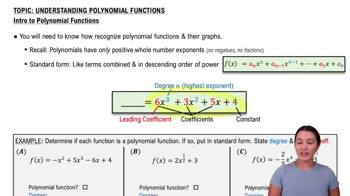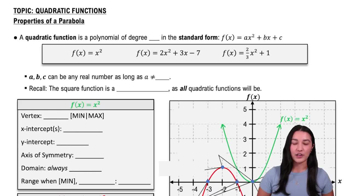Table of contents
- 0. Functions7h 52m
- Introduction to Functions16m
- Piecewise Functions10m
- Properties of Functions9m
- Common Functions1h 8m
- Transformations5m
- Combining Functions27m
- Exponent rules32m
- Exponential Functions28m
- Logarithmic Functions24m
- Properties of Logarithms34m
- Exponential & Logarithmic Equations35m
- Introduction to Trigonometric Functions38m
- Graphs of Trigonometric Functions44m
- Trigonometric Identities47m
- Inverse Trigonometric Functions48m
- 1. Limits and Continuity2h 2m
- 2. Intro to Derivatives1h 33m
- 3. Techniques of Differentiation3h 18m
- 4. Applications of Derivatives2h 38m
- 5. Graphical Applications of Derivatives6h 2m
- 6. Derivatives of Inverse, Exponential, & Logarithmic Functions2h 37m
- 7. Antiderivatives & Indefinite Integrals1h 26m
- 8. Definite Integrals4h 44m
- 9. Graphical Applications of Integrals2h 27m
- 10. Physics Applications of Integrals 2h 22m
4. Applications of Derivatives
Motion Analysis
Problem 3.6.39
Textbook Question
Matching heights A stone is thrown with an initial velocity of 32 ft/s from the edge of a bridge that is 48 ft above the ground. The height of this stone above the ground t seconds after it is thrown is f(t) = −16t²+32t+48 . If a second stone is thrown from the ground, then its height above the ground after t seconds is given by g(t) = −16t²+v0t, where v0 is the initial velocity of the second stone. Determine the value of v0 such that both stones reach the same high point.
 Verified step by step guidance
Verified step by step guidance1
First, identify the maximum height of the first stone. The function f(t) = −16t² + 32t + 48 represents the height of the first stone. To find the maximum height, we need to find the vertex of this quadratic function.
The vertex of a quadratic function ax² + bx + c is given by the formula t = -b/(2a). For f(t), a = -16 and b = 32. Substitute these values into the formula to find the time t at which the first stone reaches its maximum height.
Once you have the time t, substitute it back into the function f(t) to find the maximum height of the first stone.
Now, consider the second stone's height function g(t) = −16t² + v0t. We want this stone to reach the same maximum height as the first stone. Set g(t) equal to the maximum height found from f(t) and solve for v0.
To solve for v0, substitute the time t (found from the vertex calculation) into g(t) and set it equal to the maximum height of the first stone. Solve the resulting equation for v0 to find the initial velocity required for the second stone to reach the same height.
 Verified video answer for a similar problem:
Verified video answer for a similar problem:This video solution was recommended by our tutors as helpful for the problem above
Video duration:
7mPlay a video:
Was this helpful?
Key Concepts
Here are the essential concepts you must grasp in order to answer the question correctly.
Quadratic Functions
Quadratic functions are polynomial functions of degree two, typically expressed in the form f(t) = at² + bt + c. In this context, both height functions f(t) and g(t) are quadratic, representing the motion of the stones under the influence of gravity. Understanding the properties of these functions, such as their vertex and maximum height, is crucial for determining when both stones reach the same height.
Recommended video:

Introduction to Polynomial Functions
Vertex of a Parabola
The vertex of a parabola is the highest or lowest point of the graph, depending on its orientation. For the given height functions, the vertex represents the maximum height reached by each stone. The vertex can be found using the formula t = -b/(2a), where a and b are coefficients from the quadratic equation, allowing us to calculate the time at which each stone reaches its peak height.
Recommended video:

Properties of Parabolas
Initial Velocity and Its Impact
Initial velocity is the speed at which an object is thrown or projected at the start of its motion. In this problem, the initial velocity v0 of the second stone affects its height function g(t) and ultimately determines the time and height at which it reaches its maximum. By equating the maximum heights of both stones, we can solve for v0, ensuring both stones reach the same high point.
Recommended video:

Initial Value Problems Example 2

 6:29m
6:29mWatch next
Master Derivatives Applied To Velocity with a bite sized video explanation from Nick
Start learning




